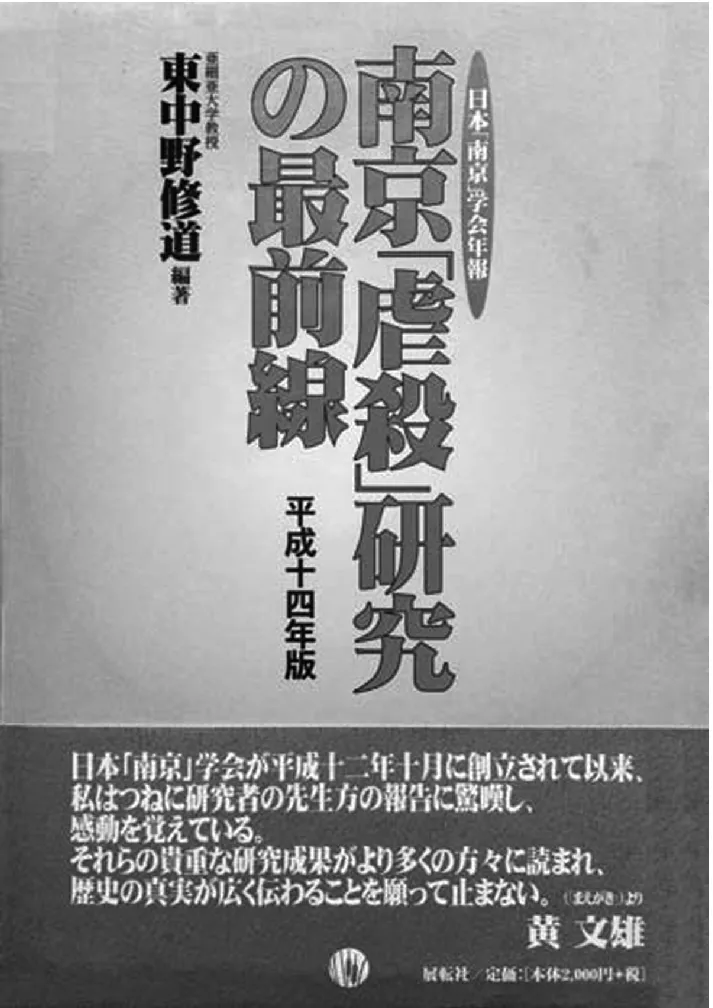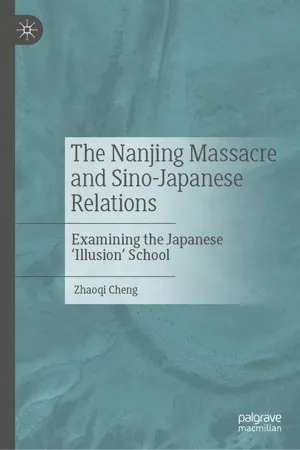1 The Emergence of the “Association” and Its Annual in the Context of Right Deviation
After the cold war, especially after the mid-1990 s, Japan’s conservatives staged a comeback, not only sharply weakening the left-wing forces (e.g., Japan Socialist Party lost seats in the Diet to such a degree that they had to change the party name) but also severely impacting the educational and academic circles which the right-wing, for a long time, had the most difficulty with. Embracing the full-scale right deviation waves, varieties of groups emerged like the Association for Historical Liberalism Studies, the Society for New Textbook Compilation and so on. They published a large quantity of writing disavowing historical facts1 and frequently organized a variety of activities demanding for the “settlement” of old scores and “rehabilitation” of the so-called “honor” of modern Japan history. They became a particularly powerful branch of right deviation waves and helped bring about the rightward shift of Japanese society as a whole.
Among the so-called “being wronged” cases, the Nanjing Massacre is considered to be the most notable. For instance, the book The Alleged “Nanking Massacre” is subtitled “Japan’s Rebuttal to China’s Forged Claims”.2 Ooi Mitsuru says that the Nanjing Massacre is “made up by words”.3 Yoshimoto says that the Nanjing Massacre just “smears our history with lies”.4 Fuji Nobuo says that the Nanjing Massacre is “a mere fiction by the Tokyo Trial”.5 Matsumura Toshio says that the Nanjing Massacre is “just a lie supported by testimonies without proof”.6 Nobukatsu Fujioka says that the Nanjing Massacre is just “a dark rumor” with “anti-Japan sentiment”.7 And Shudo Higashinakano claims that the “Nanking Massacre” is based on quite indirect historical materials and that there exists no record that can affirm how many people were killed in Nanjing. He even believes that the Nanking Massacre is a globally shared illusion.8 Kitamura Minoru underlines that the “Nanking Incident” is “closely linked with” “Kuo Min Tang (KMT)’s international propagation and foreign policy”.9 Suzuki Aki doesn’t want to be straightforward but says that he, through efforts, has touched the actual kernel of the Nanking Massacre.10 In other words, the truth is that it was fabricated. Suffering such heated discussion, the Nanjing Massacre has been no more a topic limited to historian circle but a frequent topic of popular publications.
The talk that the Japanese “Nanjing Massacre is fiction” dates back to 1970 s.11 Since then, supporters (i.e., the school of fiction) and opponents (i.e., the school of slaughter) have been busy with mutual refutation. Before the mid-1990 s, the school of slaughter had the upper hand—the school of fiction claimed to have won many times, but it was not until modern times that they had an edge over their opponents’ voices. This turn of course resulted from the rightward background, but two other factors exist: For one thing, compared to scholars of the school of slaughter who are experienced in Sino-Japanese War studies, such as Tomio Hora 12 and Akira Fujiwara ,13 the earlier fictionalists are mainly those who engage in media or were personally involved in the incident (Suzuki Aki 14 and Aroken-ichi15 fall with the former group and Tanaka Masaaki ,16 Yamamoto Shichihei 17 and Unemoto Masaki 18 belong to the latter) so that they have neither academic support nor public trust. But in modern times, the school of fiction has not only admitted people of all kinds like Kobayashi Yoshinori ,19 but have active figures, those institution scholars such as Shudo Higashinakano ,20 Nobukatsu Fujioka ,21 Watanabe Shoichi ,22 and Kitamura Minoru ,23 a budding one. Some researchers depart from their original stand, propelling the middle-of-the-road and fictionalists to collaborate. For example, Hata Ikuhiko , who has made great efforts in Sino-Japan wars studies, leans toward resistance to China from assistance to China. Since his case is typical, a little bit further introduction is a must. Hata Ikuhiko is a middle-of-the-road representative and has long advocated that during the Nanjing Massacre 40,000 people were killed. Therefore, he is not accepted by Chinese academic circle or overseas Chinese24 and was attacked by fictionalists.25 However, his institutional research mainly plays the part in swaying those fictionalists. And he cannot be regarded as deleterious. For example, facing fictionalists’ doubt on the figure, he said:
Some people even falsify the first-hand data and insist that there never exists Nanjing Massacre. Some people merely care about the token figure of 30,000 or 40,000 people that the Chinese government insists on. Should the anti-Japanese group in the United States say that the number recorded in textbooks of people killed in the atomic bomb explosion is ‘too large’ or ‘fabricated’ (the real number is still unclear) and begin to protest, what would the victims think of it? The exact figure may be controversial, but the massacre and various illegal acts committed by the Japanese army in Nanjing are undeniable facts. I, as a Japanese, genuinely apologize to the Chinese people.26
From such standpoint, his “negation” is made in a more subtle way but can be too overt. But his present standpoint does seem backward, which will be briefly discussed later.

The school of slaughter formed their own academic group the “Association for Nanjing Incident Investigation” as early as 1984 while fictionalists have long been unorganized. It wasn’t until 2000 that they began to organize those like-minded individuals, raise a banner and form the “Association for Nanjing Studies”. Fictionalists mainly attack the school of slaughter, but without tolerance of dissent, they and middle-of-the-road members attack each other from time to time. However, the Association for Nanjing Studies also admits those middle-of-the-road figures during this time. This may be a major shift in their strategy. (It is said that since the president, vice president and other major figures of the Association are all fictionalists, they actively contributed to the admission.) Recently, the Association for Nanjing Studies has launched the first publication, the Annual of the Association for Nanjing Studies: Studies in Nanjing “Massacre” at the Cutting Edge (hereinafter called “the Annual”). The Annual is composed of four articles respectively written by Hata Ikuhiko, Hara Takeshi, Tomizawa Shigenobu and Higashinakano Shudo, an interview of Susumu Maruyama, a member of the Nanjing Secret Service, a preface and a postscript. Shudo Higashinakano, president of the Association, has put in the postscript as follows: “There can be nothing but discrepancy between the ‘Nanjing Massacre’ that we talk about today and ‘the actual situation at that time’, which may be likened to that ‘cash on hand doesn’t tally with the figure in the accounts.’ Hence, the Association for Nanjing Studies is intended to ‘check the accounts one by one again’. ‘It is not for private interests, nor for certain historical conception.’ It is but to ‘find out and clarify conflicts and doubts’”.27 Ko Bunyu, who prefaces the Annual, claims:
According to Chinese “testimony”, Japanese armies slaughtered people in all forms. But none have been documented in Japanese history. Why? Because it is simply the depiction of Chinese-style massacre.The contradiction between the School of Fiction and the School of Slaughter (in Japan) can be simply presented as that between instigators of anti-Japan sentiment and academics. I agree that the Nanjing Massacre is the outcome of China’s “intelligence war.” It can be said to be the biggest hit of the Chinese government’s anti-Japanese policy after the war. And they oppose the “academic research” of the Japanese because this hit has been challenged.28
Apart from “academic research” in the preface written by Huang, and the vicious comment on the massacre claim as “incitement”, members from Nanjing Studies Association of Japan neither use coarse language like YOSHINORI Kobayashi, nor behave wantonly as usual, such as “to rip off someone’s mask”,29 even nor mark the “Declaration of Victory”30 on paper tapes, flaps and title pages. Losing temper always means failure while keeping impassivity means success; therefore, whether this kind of low profile is different from the past does it indicate a kind of self-confidence? Questions raised in Annuals mainly include the following aspects: The first is about the death toll, which links with other questions such as the population of Nanjing, interments by Red Cross Society and Zhongshan Hall; the second is about the legality of the judgment of the Tokyo Trial; the third is whether there were any relevant reports at that time. These questions have been put forward for many years; however, this time there are some “innovations” in the way and statements of drawing the conclusion. Although changes in the form generally are not enough to alter the essence of the issue, members in the Association only harp on the same string, which is far from their expectation of denying the Nanjing Massacre. But some revised statements do confuse people; therefore, it is necessary for Chinese academia to respond.
2 The “Beguilement” of “Impartial Database”31
Tomizawa Shigenobu publishes his article To Clarify the Nanjing Incident in Accordance with Database32 in Annuals which occupies the largest length and surpasses the sum of the other three articles. Mr. Tomizawa claims that recently he has input all documents related to the early Nanjing Massacre into the computer and established a “system of explanatory concepts” for the Nanjing Incident with events as its longitudes and time as its latitudes. According to him, this system refers to the following:
The totality of explanatory concepts covers all phenomena that should be expounded, among which there is no gap, showing that extensions of concepts do not overlap. As explanatory concepts, the way of five “W” and one “H” is adopted to classify all events. Five “W” refers to who, what, when, where and why, and “H” is “How”; that is to say, this way is to clarify when, where, why, what and how the victim suffered, as well as who the victim was.33
Mr. Tomizawa believes that “there is no subjective effect of the author because all of the data is extracted mechanically”. Therefore, a “completely impartial” database (and he regards this database as the national property of Nanjing Incident studies in Japan)34 can be established as long as original documents inputted are not “influenced by preferences”. The author asserts that his “belief” is “to be faithful to the original text”, which guarantees all original documents input into the computer are not influenced by his preferences; in that case, the article composed on the basis of the database definitely draws a “completely impartial” conclusion.
There will be a brand new challenge on condition that the “da...
